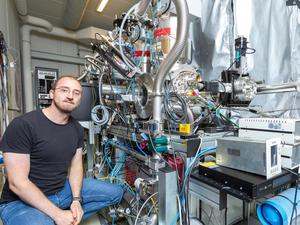Humboldt Fellow at DESY and CFEL
29 September, 2023
Ivo Vinklarek will examine ultrafast reactions of halogenated hydrocarbons in order to better understand atmospheric chemistry.
When Ivo Vinklarek was finishing his Ph.D. in Prague at the J. Heyrovský Institute of Physical Chemistry of the Czech Academy of Sciences, his advisor helped connect him to colleagues he knew in Hamburg. Vinklarek was studying the chemistry of a particular class of chemicals important to reactions in the atmosphere. The colleagues in Hamburg with whom he came into contact included DESY leading scientist Jochen Küpper, who invited Vinklarek to participate in experiments of his group in DESY’s laser labs and later also at the European XFEL. “That opened my eyes to what one could do with ultrafast methods,” Vinklarek says – and that was the first step to him being awarded an Alexander von Humboldt Fellowship, which he is now starting. For the next two years, Vinklarek will pursue his research as a postdoc in Küpper’s group at the Center for Free-Electron Laser Science.
“Here I can study the same chemistry I was studying in Prague, but with different dimensions, in particular time scales,” says Vinklarek. His topic is clusters containing halogenated hydrocarbons, which are hydrocarbons that contain atoms such as fluorine, chlorine, bromine, and iodine. Halogenated hydrocarbons become highly chemically active in the upper atmosphere. The most infamous case was that of chlorofluorocarbons (CFCs), a class of refrigerants and propellants which in the late 20th Century were implicated in the destruction of parts the Earth’s ozone layer that shields the planet’s surface from ultraviolet radiation. Although many halogenated hydrocarbons were subsequently by and large phased out in industrial and consumer use in response to the ozone layer depletion, they still exist in the atmosphere, stemming from both human-made and natural sources.
Vinklarek wants to get a more detailed understanding of halogen reactions that take place in the atmosphere. Using the ultrafast imaging methods employed by Küpper’s CFEL Controlled Molecule Imaging group, he will examine small clusters that mimic short-lived agglomerations called collision complexes that exist between the halogenated hydrocarbon, oxygen, and water. “It’s impossible to conduct these experiments in the atmosphere where they take place,” he says. The reactions take place very high in the atmosphere and are initiated by different kinds of radiation from the sun or outer space that do not exist at ground level on Earth. “The radiation up there is why these molecules have an enormous effect on atmospheric chemistry.”
That’s where Jochen Küpper’s Controlled Molecule Imaging group at CFEL is essential: their control methods spatially resolve and separate molecular sample systems. Exploiting ultrashort-pulse laser setups and free-electron laser instrumentation such as at FLASH or the European XFEL, Vinklarek will use a custom-designed experiment setup to isolate the relevant molecules and excite them using optical lasers to study the elementary processes of aerosol chemistry in real time. “Ivo brings a new setting into our work through his experience with atmospheric systems,” Küpper says. “This is an entirely new application field for us – we’ve done similar studies on biochemical systems, but within the atmosphere, this is novel.”
The first target of these studies: the naturally occurring halogenated hydrocarbons. Molecules such as chloromethane and iodomethane appear in the upper atmosphere as a result of processes taking place in some algae, marshy plants, and phytoplankton, but they also are important byproducts of several industrial processes, including the burning of organic waste in sugar production as well as the generation of silicone and some plastics and foams. “If we can first understand the fundamental processes behind the reactions involving these relatively smaller halogenated hydrocarbons, then we can expand to larger ones,” Vinklarek says. He is particularly interested in seeing how energy and electrons transfer within these collision complexes.
The fellowship begins officially on 1 October and will last 2 years. Previous Alexander von Humboldt fellows in Küpper’s group, Jolijn Onvlee and Andrea Trabattoni, started junior research groups or professorships shortly after the end of the fellowship.
